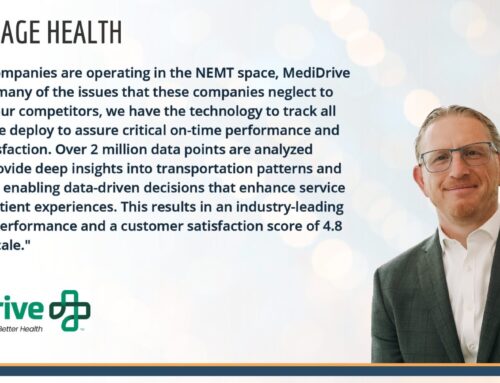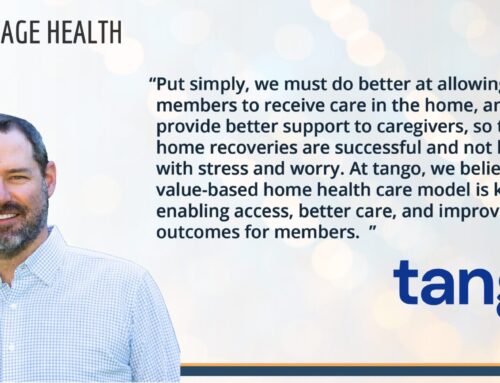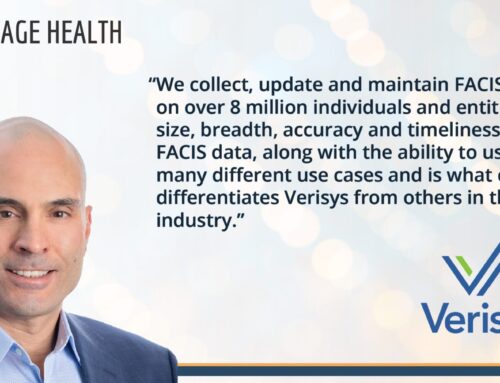
Issue 3, February 2019
Welcome to the first 2019 issue of Leverage Insights. Leverage Insights offers a uniquely insightful and actionable view into the healthcare marketplace. We are proud and grateful to share the experiences and knowledge of the industry leaders participating in Leverage Insights. Our relationships with these experts have long been a critical asset to our organization and now we are honored to bring that expertise to you.
Leverage Insights typically has two sections in each issue:
“Industry Intel” – Providing relevant information from active industry executives on key operational issues which drive our industry
And
“Market Influencers” – Highlighting a stimulating topic spoken from business leaders that aims to educate the audience on an important subject
Due to the significance of this topic, we combine both sections to focus on four eminent industry leaders who share critical information on the opioid epidemic.
The issues related to opioids and overall addiction are a true national emergency. In 2016, there were 11.8 million past year opioid misusers aged 12 or older in the United States, the vast majority of whom misused prescription pain relievers [1] while appropriately 47,000 Americans died from a drug overdose involving opioids in 2017[2].
We urge you to read this issue in full. As industry leaders, we all need to be informed and working towards a solution.
You won’t want to miss a word of this interview with these four experts: Secretary David Shulkin, Dr. Harold Paz, M.D., former Executive Vice President and Chief Medical Officer of Aetna, a CVS Health company, Dr. Steve Friedhoff, Chief Clinical Officer at Anthem, and Dr. Jay Butterman, Chief Medical Officer of Centene’s Behavioral Health Business.
— Richard Lungen
[1] https://www.samhsa.gov/data/sites/default/files/NSDUH-FFR1-2016/NSDUH-FFR1-2016.pdf
[2] https://www.drugabuse.gov/related-topics/trends-statistics/overdose-death-rates
The Opioid Epidemic—Expert Intelligence on this Industry Challenge
Today’s conversation is moderated by Richard Lungen of Leverage Health.
Leverage Health: Before we begin, I want to thank Secretary Shulkin for joining our conversation. Today, we’ll discuss how the industry is addressing one of today’s most challenging problems, the opioid epidemic. Let’s start with an overview of how each of you, in your respective positions, is approaching this issue.[/text_output][/vc_column_inner][/vc_row_inner][text_output]Dr. Paz: At CVS Health-Aetna, the opioid epidemic is a priority, and I lead an Aetna task force of clinicians and business leaders who are applying a three-part strategy of prevention, intervention, and support for the members, customers, and communities we serve.
Dr. Friedhoff: This epidemic is also a priority for Anthem, where I’m responsible for medical management and behavioral health integration. Although historically we’ve talked about physical and behavioral health as distinct entities defined by benefits, when we view opioid misuse, or any other disorder, through a primary-care, patient-centric perspective, it’s clear that physical and behavioral health are inextricable.
Dr. Butterman: I’m a psychiatrist with psychopharmacological training and experience overseeing chemical-dependency treatments in the military. As Chief Medical Officer of Centene’s behavioral health business, I’ve been very involved not only with the opioid epidemic, but also with the issues of chemical dependency and substance-use disorder in general. I agree that there’s little in the world of physical health that isn’t impacted by behavioral health, and vice versa. As we’ve learned about substance disorders, we’ve seen that the physiological impact is much greater than we realized a decade or two ago.
Secretary Shulkin: The opioid issue is very important in the V.A., as veterans have a higher prevalence of opioid use than the general population. In part it’s so high because 60 percent of veterans in the V.A. system have chronic pain, behavioral health issues, or both.
The opioid issue is very important in the V.A., as veterans have a higher prevalence of opioid use than the general population. In part it’s so high because 60 percent of veterans in the V.A. system have chronic pain, behavioral health issues, or both.
Secretary David Shulkin
Leverage Health: Running what is, at its core, the largest health system in the world, what specific approaches has the V.A. taken to combat opioid addiction? What has worked and not worked, and what’s still being worked on?
Secretary Shulkin: Because chronic pain and behavioral issues are such big problems in the V.A. system, and because the V.A. has 20 years of data in one place, the department could see by late 2008 that opioid addiction was a growing issue. In early 2009, the V.A. started its Opioid Safety Initiative, taking a multifaceted approach to the problem using an opioid safety toolkit and distributing it to 375,000 employees.
Working with the Department of Defense, the V.A. created team-practice guidelines, issuing provider-specific reports on practice patterns. We required informed consent for every veteran for whom we prescribed medications, regularly monitoring for benzodiazepines and other types of substance-abuse testing. We built treatment alternatives that focused on complementary care, and developed a stepped-care model that included alternatives to opioids. Then, working with our prescribers, we implemented academic detailing with our pharmacists. Finally, we initiated a fairly extensive nationwide program of naloxone distribution. Since the start of the initiative in 2009, we’ve reduced the V.A.’s overall prescribing and use of opioids by 36 percent, and have seen a 90 percent decrease in first-start opioid use among vets nationwide. Any continued use of opioids tends to be chronic.
The Trump administration has made this issue highly visible. The President’s brother suffered from alcoholism, and President Trump sees substance abuse and alcoholism as public health crises. Governor Christie chaired a National Commission, which the V.A. participated in. In addition to making this issue a higher priority, the biggest step that I took was to share all the prescribing data among all the V.A. medical centers. Given the size of your companies, you must all see tremendous variation in prescribing practices. For the V.A., the highest prescription use for opioids, 20 percent of all prescriptions, is at our Roseburg, Oregon campus. Cleveland, Ohio has the lowest incidence, with less than three percent of all prescriptions
Leverage Health: Thank you, Secretary. As leaders in large health plans, how, in your views, did this problem become so dire, how have you tried to mitigate it, and which of your efforts have been most successful? Lastly, how might you improve on these efforts? Dr. Friedhoff?[
Dr. Friedhoff: A book by Sam Quinones, Dreamland: The True Tale of America’s Opiate Epidemic, does a tremendous job of describing how a perfect storm of the increased treatment of pain, the promotion of opioids via overprescribing, certain socioeconomic conditions, and even an element of organized crime, all escalated this epidemic. The book highlights how the problem came to be, in both an anecdotal and a somewhat data-driven fashion.
If one looks at the Center for Disease Control’s (CDC) data around the number of prescriptions written over the last 25 years, with 76 million in 1991, increasing to 207 million in 2013—and I can’t even imagine those numbers if they were trended out—one sees the factors I just mentioned. Overprescribing, coupled with the stigma around behavioral health and substance-use-disorder treatment, all contribute to the crisis.
If one looks at the Center for Disease Control’s (CDC) data around the number of prescriptions written over the last 25 years . . . [it shows] 76 million [prescriptions] in 1991, increasing to 207 million in 2013. . . .
Dr. Steve Friedhoff
Our approach at Anthem is also three-pronged: a strategy of prevention/deterrence, treatment, and recovery/resilience. Company-wide, we’ve reduced the number of opioid prescriptions filled at pharmacies by 30 percent. We’ve also limited some short-acting opioid coverage to seven days, achieving a reduction of more than 40 percent two years ahead of schedule.
Still, reducing the number of opioids prescribed without offering support for recovery won’t win the battle. Heroin remains a cheap and accessible alternative. Over the next two years, a priority at Anthem is to ensure that at least four in every ten members with opioid-use disorder receive comprehensive medicine-assisted treatment, combining both behavioral health and counseling components along with medication. We’ve also announced our participation in the Shatterproof Coalition, where the goal is to build a quality-rating system for addiction-treatment programs, measuring which practices are evidence-based and which provide the best chance of patient success.
Dr. Paz: Bringing more transparency to the addiction-treatment system offers real advantages, and I’m sure we’ve all seen that treatment centers vary. We must combine past accomplishments with ongoing research and new evidence as we continue to evaluate programs and policies.
Leverage Health: Thank you, Dr. Paz. You’re an executive who shares quite a lot of information with the public. Could you speak about how all this intersects with Aetna’s merger with CVS?
Dr. Paz: One thing that strikes me when I look at a hot-spot map of opioid addiction and overdose is how uneven the impact is. Although it’s a tragic national epidemic, it affects some communities much more than others. There can be a sixfold difference between different parts of the country, and this should give us, and everyone else, important insights into what the solutions need to be.
One thing that strikes me when I look at the hot-spot map of opioid addiction and overdose is how uneven the impact is. Although it’s a tragic national epidemic, it affects some communities much more than others. There can be a sixfold difference between different parts of the country.
Dr. Harold Paz
In partnership with the Harvard School of Public Health, Aetna recently launched a Wellbeing Index that looks at a broad definition of wellbeing that includes physical health, emotional health, social connectedness, purpose, financial security, and character strengths. Each of these factors plays a large role in how individuals are able to navigate everyday challenges. In communities with high unemployment or underemployment, these behavioral, social, and environmental determinants of health become very important.
At Aetna, we’ve taken an enterprise-wide approach to how we can go into these communities and address individual needs through personalized health. To reduce inappropriate opioid prescribing for our members with diagnoses of opioid abuse, we looked at how behavioral-health clinicians can perform substance-abuse screening and intervention. We also write letters—I’ve personally written over a thousand—to physicians and dentists who may appear to overprescribe opioids, providing them with CDC recommendations for daily supply limits, dosing limits on initial prescriptions, and pain-treatment strategies.
In 2018, Aetna launched a mindfulness training program called Living with Chronic Pain. We encourage non-opioid pain treatments such as chiropractic care, acupuncture, biofeedback, and physical therapy. In our educational programs, we underscored that, in many cases, acetaminophen or NSAIDs are likely to be more effective for acute injuries—not equally effective, but more effective than opioids. We’ve also had multiple working sessions with the CDC about our initiatives.
Through our Aetna Pharmacy Substance Control Use Programs, we identify at-risk members and intervene. We launched a Neonatal Abstinence Syndrome Program for our Medicaid members in Kentucky and West Virginia, where we support women with babies at risk for opioid withdrawal.
Additionally, we waive copays to make Narcan more available for many of our fully insured commercial members after they meet their deductible. We’ve helped to address the needs of pregnant mothers using opioids, and we’ve enabled access to morphine without prior authorization requirements, thus reducing barriers to medication-assisted treatment (MAT).
We’ve also worked with Catholic Charities to expand children’s behavioral health services to include adolescent substance-abuse recovery and treatment. And we’ve launched innovative programs, such as our Guardian Angel Program, in which Aetna clinicians motivate victims of opioid overdose to enter programs for treatment and support. Launched in 2018, the program has already helped several hundred members. We’ve reached many of the members and their families and provided them with education on Narcan, making behavioral and case-management referrals for these individuals. It’s a program we want to expand, because we think that this personalized approach considers the drivers for opioid-use disorder, both individually and within families and communities.
In addition, the Aetna Foundation provides funding at state and local levels to address opioid-related challenges. For example, the Foundation distributes Narcan in states such as Maryland, Pennsylvania, and Kentucky, and funds training for first responders, so that people who might otherwise die from overdoses are given a second chance.
Secretary Shulkin: Has anyone here been able to quantify how many people with opioid-use disorder you’re targeting within your health system?
Dr. Friedhoff: Yes. In fact, we’ve been working on other methodologies that utilize more advanced predictive models. There are those with known diagnoses of substance-use or opioid-use disorder—people, for instance, who’ve presented to the emergency department with an overdose. But we’re also using a model that employs AI to identify individuals who have not been diagnosed but are likely to have this disorder.
Depending on the sensitivity of the predictive model, we’re finding three to seven times the number of individuals who are likely to have an opioid-use disorder than we did when we relied only on a diagnosis via submitted claims.
[Through the use of AI] we’ll be able to target individuals for potential interventions who may not yet have had a formal diagnosis. Depending on the sensitivity of the predictive model, we’re finding three to seven times the number of individuals who are likely to have an opioid-use disorder than we did when we relied only on a diagnosis via submitted claims.
Dr. Steve Friedhoff
Secretary Shulkin: Do you have a sense of what percentage of your population might be suffering from this disorder?
Dr. Friedhoff: The percentage depends on whether we look at commercial or Medicaid/Medicare memberships and at other subcomponents within the line of business. In some populations, estimates of those who suffer, or who at least have some markers for concern, are as high as 10 percent of the population.
Secretary Shulkin: Is there a higher prevalence of the disorder in economically disadvantaged populations?
Dr. Friedhoff: Again, if you look by the line of business and zip code, it varies significantly by product, and especially by region. As I’m sure all of you have, we created heat maps of our own population. It’s no surprise that what you see in Appalachia and other rural areas is very different from the substance-use epidemics we’ve seen in the past.
Dr. Paz: As opposed to a health system, most of the data that we work with are claims data, which are only as good as the coding. If an event isn’t coded correctly, there’s a chance of missing it, and that’s where we see opportunity. If the coding is correct on the claims data, we can better identify who’s at risk.
Dr. Butterman: A quick comment on the identification of how many people are actually addicted: I agree, it’s very challenging, because many of the people with opioid-use disorders present them as secondary issues, so we may not pick up on them, and these people may not receive the type of intervention that we end up coding for. One of the things we’ve done at Centene is to develop proprietary AI methods that identify individuals who may be at greater risk than assumed. Though not fully validated yet, the preliminary results of this method look good.
Many of the people with opioid-use disorders present them as secondary issues, so . . . these people may not receive the type of intervention that we end up coding for. One of the things we’ve done at Centene is to develop proprietary AI methods that identify individuals who may be at greater risk than assumed.
Dr. Jay Butterman
Secretary Shulkin: Whether it’s claims or episodic visits, all your organizations have the ability to identify those at high risk for opioid substance abuse. To connect these people with effective treatments, I wonder if you’re looking at provider access or shortage as a key issue. In other words, are there enough providers to treat pain and deal with opioid addiction?
Dr. Paz: In some geographic areas, there are physician shortages. On the other hand, this presents an enormous opportunity for training in medication-assisted treatment. Here in Connecticut, in terms of training for MAT, you need to be certified to prescribe Suboxone. At the Yale School of Medicine, Dr. Gail D’Onofrio, Chair of the Department of Emergency Medicine, gave physicians time off and eight hours of training so they could get certified to prescribe MAT. That kind of vision and leadership is what’s necessary with this epidemic. Rather than just saying, “It’s difficult and we’re not going to find the time,” or “We don’t have the resources,” Dr. D’Onofrio made it happen. Working with Dr. D’Onofrio, the American College of Emergency Physicians, and the National Institute on Drug Abuse, Aetna created a series of videos to help emergency physicians treat patients experiencing opioid overdose.
Leverage Health: Dr. Friedhoff, with 14 BlueCross BlueShield plans and the Amerigroup states, and even given your density of providers, is there an access-to-care problem in your states? If so, do you envision using virtual care, such as Leverage Health’s portfolio company, Thrivee, to address this problem?
Dr. Friedhoff: Access to care for behavioral health and substance-use disorders is a national issue that to some extent is based on geography, and at other times on the individual, the social barriers of a population, whether related to transportation, underlying behavioral and/or physical health challenges, the ability to leave work to obtain treatment, or the stigma associated with treatment. Access is a broad term, but access to trained providers is enormously important. For most individuals with substance-use disorders, their first point of contact is either an emergency department or their primary-care physicians. The more we can encourage not only ER but also primary-care physicians to get the training they need to prescribe MAT, the better. For example, I was amazed by how many physicians in our own primary-care network didn’t know that there were billing codes for Screening, Brief Intervention, and Referral to Treatment (SBIRT). By providing education, we saw a 60 percent increase in the number of claims coming in with SBIRT codes.
Granted, some might have been now billing for services they’d always done, but the fact that physicians weren’t necessarily even billing for those services is sort of a canary in the coal mine, and points to a lack of understanding about how they could play a bigger role in providing access. Telehealth and telemedicine also play potentially big roles. Anthem rolled out telecounseling in 2017 and telepsychiatry in 2018. For members in rural areas, where there’s a lack of transportation and easy access, these modes of support offer real potential.
Leverage Health: We’ll return to technology in a minute. Dr. Butterman, on this call, you have the greatest concentration of Medicaid members. Could you talk about scarcity of providers and lack of care in your markets?
In partnership with the American Society of Addiction Medicine (ASAM), we’ve made MAT training programs more available. Many physicians were concerned that the training would take up so much time that they wouldn’t be appropriately reimbursed for it. We’re addressing this concern.
Dr. Jay Butterman
Dr. Butterman: We’ve certainly seen a significant deficit of providers, and have been looking at all the discussed interventions. Transportation is an issue. Much of the Medicaid membership has access issues, so we’ve been looking at how to increase the number of providers who can offer MAT. In partnership with the American Society of Addiction Medicine (ASAM), we’ve made MAT training programs more available. Many physicians were concerned that the training would take up so much time that they wouldn’t be appropriately reimbursed for it. We’re addressing this concern.
But having a provider support network adequate to the number of opioid-use-disorder patients is always challenging. We’re also expanding our telemedicine programs, and helping members for whom transportation is a barrier to care.
Dr. Paz: Since you brought up technology, Richard, our members now have access to a provider-network search engine that identifies physicians and dentists who offer pain-management solutions other than opioids. In addition, Aetna is the first and only dental carrier to cover Exparel, a non-opioid treatment for wisdom-tooth extractions, and we’re now piloting this coverage for other procedures in some ambulatory surgery centers.
Our members now have access to a provider-network search engine that identifies physicians and dentists who offer pain-management solutions other than opioids.
Dr. Harold Paz
Leverage Health: Dr. Butterman, given Centene’s Medicaid population, do you think your membership will engage with this kind of technology at scale?
Dr. Butterman: I think we’ve seen some success here, though it’s not been as robust as we’d hoped for, and there have been some abuses of the technology interventions we’ve tried. It comes down to finding methods of engagement that are more palatable to our populations. Technology is critical, and we continue to search for forms that work for the Medicaid population.
Secretary Shulkin: What other effective treatment options are on the horizon?
Dr. Paz: Exparel is one example. And there are other non-opioid drugs that effectively alleviate post-op pain.
Secretary Shulkin: Are any of you working on strategies to help your primary-care physicians identify or treat opioid substance-abuse disorders?
Dr. Friedhoff: We’re distributing new educational programs, like Project ECHO [Extension for Community Healthcare Outcomes], to engage providers. We’re also looking at other incentives for physicians who identify and intervene with initial treatment. In the end, however, it gets down to physicians being aware of and willing to address this disorder. We must continue to engage with and inspire providers to be active, invested partners, doing what we all believe is best for our membership and populations.
In the end, however, it gets down to physicians being aware of and willing to address this disorder. We must continue to engage with and inspire providers to be active, invested partners, doing what we all believe is best for our membership and populations.
Dr. Steve Friedhoff
Leverage Health: Dr. Butterman, how is Centene using provider educational programs to improve care?
Dr. Butterman: It’s important to meet providers where they are. Encouraging basic education on performance and things like Esper Treatment and billing for Esper, as well as Project ECHO—and, in some cases, providing third-party education and certification for MAT—is critical. Unfortunately, some providers are outliers, sometimes because of poor habits or a lack of ability, but sometimes because they don’t necessarily understand the ecosystem with which their patients interact. Thus, most payers offer education to providers that don’t know about certain treatments, and therefor aren’t prescribing them. Counter-detailing programs are helpful. We also try to reach providers who don’t appear to be outliers but who might also benefit from remedial education. Again, it’s a spectrum, and frequently regional. The strategy must be multipronged.
Leverage Health: We have around 70 to 80 million insured Americans represented on this call today, and that’s without CVS consumers. A lot of conversations in healthcare take place in which payers don’t want to share information about their initiatives. This is one of the best examples of a multipayer initiative being able to affect both providers and patients. With that said, I’d like to ask what role you think federal and/or state government should play.
Dr. Friedhoff: Looked at from a couple of angles, first, I see the Patients and Communities Act as progress. States have the chance to leverage funding and support through this legislation, but they must have the right subject-matter experts and key stakeholders to know how best to disseminate this funding. It’s certainly important to make sure that there are no gaps in the continuum of substance-use-disorder care for Medicaid recipients.
We’re particularly passionate about the need for more dedicated research for neonatal abstinence syndrome, but also for opioid use in general. We believe that the alignment of state laws and the federal substance-use-disorder confidentiality rule with the Health Insurance Portability and Accountability Act (HIPAA) would help to ensure fluid communication among the entire treatment team, including payers and medical and specialty providers. We also believe that health plans should be granted access to Prescription Drug Monitoring Programs (PDMPs). This access to increased information, with appropriate privacy protections, would help support the delivery of more holistic and integrated care. Increasing the ability of behavioral and physical health providers to share data with one another is key. Returning to your original question, I think that payers could definitely do a better job of sharing information with other payers, states, and providers. Again, an entire ecosystem is needed, as right now no one can leverage the entire set of data.
Leverage Health: Dr. Butterman, while everyone on this call works for an organization that’s regulated by the Department of Insurance, Centene, of course, is primarily in the government insurance business, with the majority of its revenue focused on Medicaid. What role do you feel state governments should play in this initiative?
Dr. Butterman: First and foremost, we have to know who needs treatment. So many people present with one thing when in reality they have something else. The more history you have, the more easily you can identify the problem—and so, with the privacy of alcohol and drug abuse patients protected by 42 Code of Federal Regulations, we need to be able to share this information at least as well as we do other medical information.
Nationalized PDMPs, rather than statewide PDMPs, absolutely make more sense. I live in north Texas. It’s easy for someone to drive to Oklahoma and have a doctor there write a prescription. If all I can pull up is my Texas PDMP feed, I’ll never know about it. This is a national issue all payers face, and when we get together and promote a unified goal, it’s important that even the population at large knows that this isn’t just Aetna or Centene or Anthem looking for solutions, but all of us together looking to help our communities.
Nationalized Prescription Drug Monitoring Programs (PDMPs), rather than statewide PDMPs, absolutely make more sense. I live in north Texas. It’s easy for someone to drive to Oklahoma and have a doctor there write a prescription. If all I can pull up is my Texas PDMP feed, I’ll never know about it.
Dr. Jay Butterman
Leverage Health: Dr. Paz, with your recent merger, you brought all of 10,000 or so CVS locations into the same enterprise. Could you talk about the unique opportunity this gives Aetna to address this epidemic?
Dr. Paz: I would say that, globally and specifically, our retail stores do create opportunities with challenges like the opioid epidemic, but only if we work with physicians in the communities, with primary-care physicians in general, and with existing healthcare systems and hospitals and post-acute care. More and more, consumers want digital solutions, such as telehealth solutions—opportunities to have access to care in nonconventional settings. Why? Because, by some estimates, only 40 percent of Americans have a primary-care physician.
So when people walk into a Minute Clinic at a CVS, how can we provide the service they need, and also help them find a doctor who can provide ongoing care? These opportunities must be seen as a part of a holistic approach to addressing care and wellness in general. I hope we can continue to leverage them.
Leverage Health: Secretary, do you have a final rapid-fire comment or question that everyone might respond to?
Secretary Shulkin: Right now, this problem is getting attention because the press is covering it and the White House is mentioning it. Do you think it’s going to remain a high priority for organizations like yours?
Dr. Friedhoff: Regardless of what payers and other large organizations, including government regulators, do, I don’t see the opioid problem taking a back seat for the foreseeable future. This crisis didn’t evolve overnight, nor will it be resolved quickly. I don’t see us taking our foot off the pedal anytime soon.
Dr. Butterman: It will take a lot of education and use of data per intervention, but I’m very optimistic that prescribing will improve. What really worries me is the addiction to illicit opioids. Look at some of the recent statistics around fentanyl, for example. No, sadly, the problem isn’t going away, and we’ll continue to see efforts by everyone on this call, and organizations at the federal and state levels, to address it.
Dr. Paz: Agreed. Unfortunately, this situation isn’t going away any time soon. Yet having more providers out there who are committed to curbing the epidemic, who are asking the right questions, and who understand the current best practices in terms of pain-management prescribing and addiction treatment, are so important. We do see light at the end of the tunnel.
Having more providers out there who are committed to curbing the epidemic, who are asking the right questions, and who understand the current best practices in terms of pain-management prescribing and addiction treatment, are so important. We do see light at the end of the tunnel.
Dr. Harold Paz
Secretary Shulkin: Are your three organizations already sharing ideas in a forum such as Shatterproof?
Dr. Paz: Shatterproof is a great example of a forum that can bring companies together to address this epidemic.
Dr. Friedhoff: Anthem participates in Shatterproof, and we’re also collaborating with the BlueCross and BlueShield Association for the development of the Blue Distinction for Substance Use Treatment, which aims to improve patient outcomes and value by focusing on the treatment of substance-use disorder, including opioid-use disorder.
Leverage Health: Our portfolio company Thrivee also collaborates with Shatterproof. We believe it’s an important element in driving effective solutions. Yes, there’s information out there. Dreamland is an eye-opening book about this formidable epidemic, as Dr. Friedhoff noted, but having industry leaders such as you four sharing insights has the potential to drive the entire industry to meet the challenge of this epidemic. Again, thank you so much for participating.







Stay In Touch